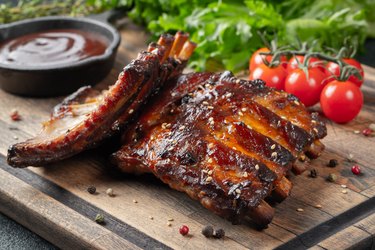
When you go to a restaurant, ordering ribs is easy. When you make ribs at home, it gets a little more complicated. There are different types of ribs, and their differences usually boil down to the type of meat (such as beef or pork ribs), the part of the animal they come from and the preparation method.
Two types of ribs that are very common but often confused are beef spare ribs and short ribs. Though they come from the same animal — a cow — they come from different parts of the cow and need to be cooked differently.
Video of the Day
Video of the Day
Here's what sets them apart so you can identify them correctly in the grocery store and know how to prepare them when you get home.
What Are Spare Ribs?
Beef spare ribs are more accurately known as beef back ribs. As the name suggests, they come from the ribs of a cow. If you've ever enjoyed barbecue ribs, there's a good chance they were made from spare ribs.
"Spare ribs are often called beef back ribs because they come from the cow's rib area, which is commonly associated with barbecued beef ribs," explains Daniel P. Craig, a chef with more than 20 years of experience working in professional kitchens.
Beef spare ribs tend to be large, so they require a longer cooking time. It's also recommended to cook them low and slow due to the texture. Another con is that there's a lot of bone to get around. Though you may have to put in some extra work to make tasty spare ribs, they're an affordable option.
"Spare ribs can be a tad chewy, but slow cooking in an oven or on the grill will make them tender," Craig says. "You can season them with salt and pepper before they hit the heat, or add sauce after they're done cooking."
What Are Short Ribs?
The name "short ribs" is a bit misleading. Beef short ribs don't actually come from a cow's ribs like spare ribs do.
"Short ribs are beef ribs from the cow's belly or 'plate cut," Craig says. This area is also sometimes called the beef chuck part of a cow.
Short ribs do have bones, but they have fewer bones than spare ribs, making it easier to get to the meat.
"They're best cooked using slow techniques like braising," Craig says. "The well-marbled meat and connective tissue provide juicy and flavorful melt-in-your-mouth texture when cooked slowly."
While braising is the traditional cooking method for beef short ribs, you can also slow-cook them. Like beef spare ribs, short ribs require a long cooking time at low temperatures to make them more tender.
Short Ribs vs. Spare Ribs Nutrition
Both beef spare ribs and short ribs are high in calories, fat and protein. Their vitamin and mineral contents differ slightly.
Per 3 oz., cooked | ||
|---|---|---|
Calories | 205 | 152 |
Total fat | 15.2 g | 9.1 g |
Saturated fat | 6.1 g | 3.8 g |
Protein | 15.9 g | 16.7 g |
Iron | 1.5 mg, 8% Daily Value | 2.27 mg, 12% DV |
Was this article helpful?
150 Characters Max
0/150
Thank you for sharing!
Thank you for your feedback!